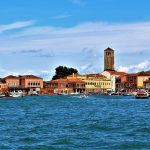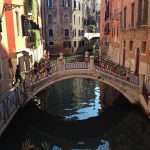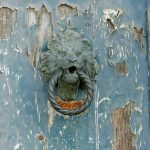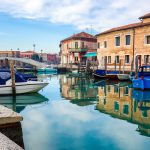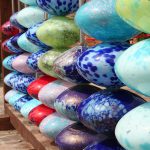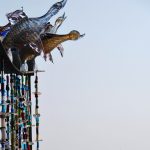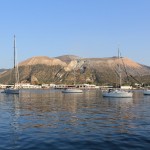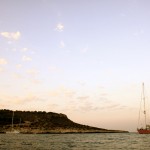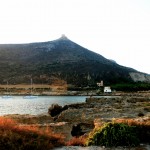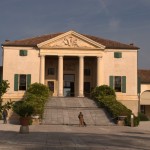Everyone is a pearl, from Elba to Ustica. Better by boat
The Islands of the Venetian Lagoon
Burano, Murano and much more: unconventional tour around Venice
by Marco Schiavina
Aznavour found it sad. Thomas Mann and Luchino Visconti found it the emblem of decadence. To me, Venice is just the most fascinating city in the world! Full of history, birthplace of many artists: Vivaldi, Albinoni, Benedetto Marcello, Canaletto, Bellini, Giorgione, Tiziano, Lotto, Canova, Tiepolo, Goldoni, Foscolo, just to mention some. Shakespeare set here some of his most famous comedies. Marco Polo started from here to reach the Far East, opening new commercial roads. The very first Western cosmopolitan city, for sure.
Every corner, every canal, every bacaro and fritolin (i.e. typical friendly taverns) set Venice’s rhythm: the tourists by day, the locals by night. It is a pleasure to get lost, find new unknown spots, make a long night in Piazza San Marco. I have always been in love with Venice, like it was a charming woman. But, you know, to love is not to live with! The buildings and canals collapsing, the aging of population, the prices getting more and more higher, the high water, the difficulties of everyday life in such a tourist and exhausting city… It seems almost impossible to live here, actually. But still, everytime I come it is kind of magic and I cannot stay away more than a couple of months.
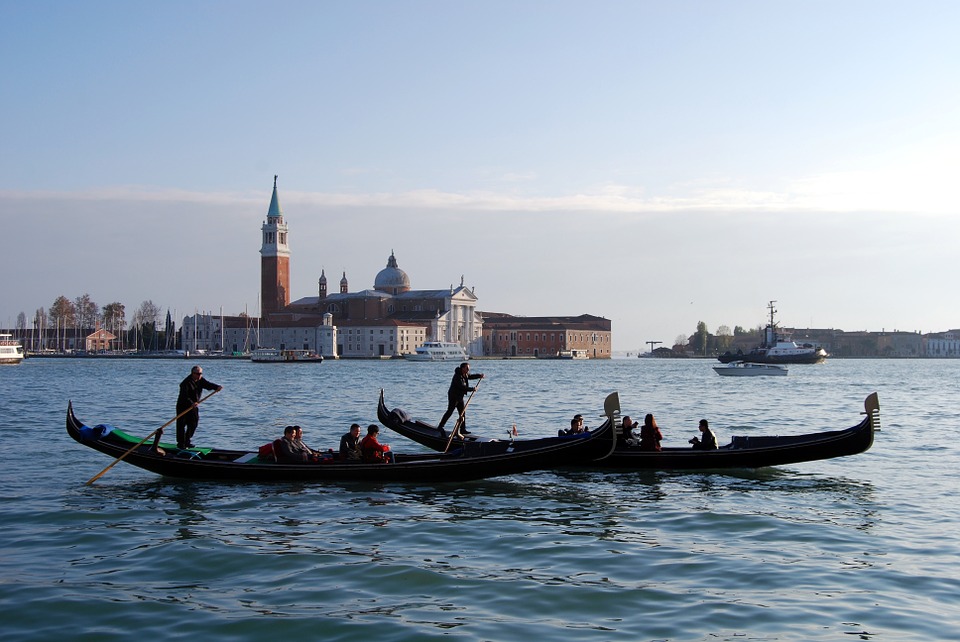
Venice, Canal Grande
Venetian lagoon tour
Here is my itinerary through the islands of Venetian lagoon: they are 118, would you believe it? Some are well known, others almost hidden or abandoned. Let’s see. The first is the island of San Michele. From Piazzale Roma, take Fondamenta Nuove and get the vaporetto to Burano island. In a minute, you will get to San Michele, the historical monumental cemetery of Venice since 1807. The graves are divided according to one’s faith, first set by the Camaldolesi, then it became a political jail. Here you can find some famous buryings: Ezra Pound, Igor Stravinskij, Luigi Nono, Helenio Herrera, etc.
- Venetian Lagoon Tour
- Venice Canals
- The Venetian lion
The island of San Francesco del Deserto (i.e. St Francis of the desert) is known as the island of two vineyards. From Burano I got a private typical boat called bragosso (typical from the high Mediterranean Sea). Sailing in the canals is not so easy because of the barene (from the word baro, meaning grass in local dialect). Those are some kind of small natural dams, protecting the islands from the flow, crucial to maintain the ecosystem of the lagoon. History goes that St Francis, back from the Far East, stopped in here. That is the reason why the noble man Jacopo Michiel gave the whole island to the Franciscan order in 1233. In the 1400s, the friars went away for a malaria outbreak, hence the name Desert. By the end of 1700s, Napoleon conquered Venice, breaking up the holy orders and turning the Church into some kind of storage. Then Venice passed under the Austrian power, using it as a powder keg. The island went back to the friars as their monastery only in the 1858. Today less than 10 monks live in here and the island is just perfect, receiving only 1500 visitors per year. Opened during the weekends to spiritual retreats or simply for tourist tours, free fee, pay-what-you-can. The island is so peaceful, I suggest you a tour of the Northern lagoon, almost until Jesolo and to the island of Santa Cristina. Once known as the island of San Marco, named after St Christine’s relics, in here since 1325. Recently mr Swarovski bought the whole island and turned it into his own paradise on Earth, closed to the public. What a pity!
Burano, island of colorful houses and lace-making
According to the histories, Venice was founded by some defectors running away from Aquileia invaded by Attila. You know, the islands were inhabited long before, during the Bronze Age yet. First in the area of the island Torcello, where today live just a few people. Then the famous island of Burano with its typical colorful houses. In the past the different shades defined the properties, nowadays it is mostly a tourist attraction. After some ombre (i.e. shadows, how the locals call a quick glass of wine), we got in Sandra Maravacchio’s lab, a skilled laces craft. She followed her family’s tradition in sewing, taught from mother to daughter. Burano’s lace is wonderful, but very expensive: it takes many days and a lot of patience to realize every single piece. There is also a school to learn how to sew the lace and Sandra is a teacher.
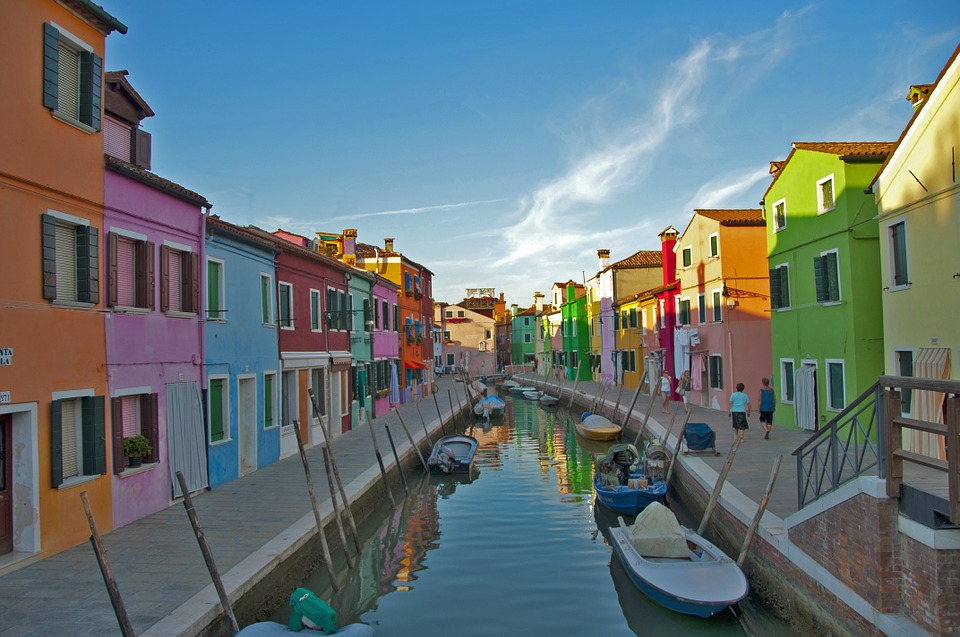
Burano Island, Venice Lagoon
You can reach the island of San Servolo by vaporetto, from San Zaccaria. Well restored, the island is an International business centre and the seat of Venice International University. Both the teachers and the students from all over the world can live on the island during the times of classes. It is also one of the bases of Biennale art exhibit. The buildings are from the 1800s, there is a Benedectine Monastery, first it was just for men, then just for women, then it turned into a military hospital and a lazaretto. In 1725 the very first mental patient was hospitalized here and you can visit the interesting mental hospital museum. In the 700s many people were hospitalized as insane, but they only had pellagra, they were depressed and thin due to their poor nutrition and a severe lack of vitamins. The peasants could afford only corn flour to eat and their only food was polenta. They were confused with mentals, but they just had to eat more and better to get well. On the island there are many pavilions, meadows, courtyards, open-air sculptures (by Pomodoro, Chia, Plessi), sports yards. The cafeteria and a cheap self-service restaurant open to the visitors. It takes 8 minutes walking from Piazza San Marco!
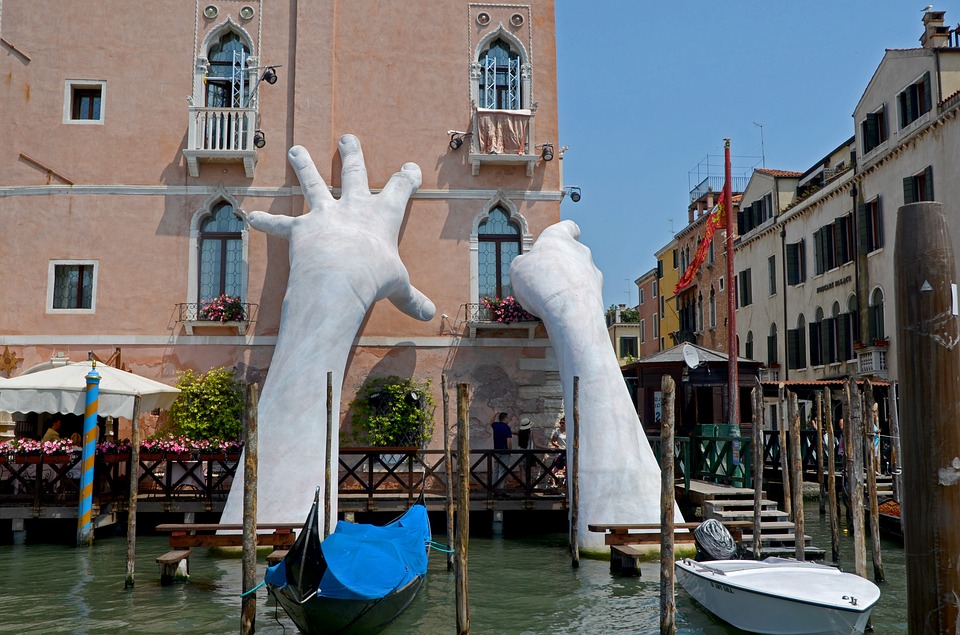
Venice, Biennale Art Exhibit
Reach the Island of San Lazzaro degli Armeni by the same ferryboat, but be careful with the schedules: the Monastery opens to guided tour only at 3 p.m, while the Sunday mass is at 11 a.m. The Monastery is one of the most important centres about Armenian culture in the world. In 1717 the Republic of Venice gave it to a bunch of monks escaped from Turk persecution in Istanbul, they survived as a religious order under Napoleon’s Era because one of his counselors was Armenian. They restored the church, built the monastery, widened the island surface and brought here their treasures: 200.000 volumes, 4.000 manuscripts, crafts from Saudi, India, Egypt. In 1816 Lord Byron lived on the island for a while to study the Armenian. Nowadays the monks proudly produce a fine rose jam you should taste and buy.
Murano, island of glass factories
Next stop: the island of Murano, to visit a glass furnace. From Venice, take the vaporetto number 41 to Fondamenta Nuove and the coincidence to Murano (it takes a while, almost 1 hour in all). The glass was discovered by the Phoenicians and improved by the Egyptians, then it came to Venice in the year 1000 through the merchants of the Serenissima Republic, who walked all along the Mediterranean Sea. Many glassworks were built, first inside the city, then moved to Murano in 1296, fearing of fires. Here the technique was further improved and a skilled Master could even marry the Doge’s daughter! During the centuries the glass art has become higher and higher, but in the 70s it had a stop and by now there are only about fifty glassworks, fighting against the economical cyrisis and the lack of sales. In the lab we visited, three craftsman created in syncrony a wonderful glass goblet in front of us: one blew, the second made the shape, the third leaked the glass paste. It takes hours for the paste to get the shape inside the owen, at a lower temperature than the one of cooking, almost 1.250°C. Every night a “omo de note” (i.e. man-of-the-night, a melter) works to realize this paste, mixing all the ingredients together and everyone has got his own recipe, as it happens for the restaurants. The products are quite expensive: our goblet costed 70€, but a special jug taking one working day to be made could cost 1500€ or more.
- Murano Island, Venice Lagoon
- Murano glass art
- Murano glass art
We spent our last day at the Lazzaretto Nuovo, it takes 30 minutes from Fondamenta Nuove by the vaporetto number 13. The stop is on request, ask to the pilot. The island was already populated during the Bronze Age, the first written doc dates back to the 1015, when the island was called Vigna Murada. In 1468 the Serenissima Republic decided to set here a Lazaretto to prevent epidemics. The boats considered a risk for the plague were forced to wait here. The rats on the boats infected the sailors with plague. The boats were full cleaned and all the goods were purified with aromatic smokes, washing and sun expositions inside a wide structure called Teson Grande where on the walls you can still read some notes written by the bastasi, the porters who had to do this cleaning job. The sailors on those boats were hospitalized and waited 40 days in a closed hospital to heal completely. If not, they were moved in the Old Lazaretto. The doctor who had to state the health of those sailors has become the Venetian Carnival character “the Doctor”: black dressed, wearing a mask with a long beak full of herbs and aromas to avoid the contagion. The concept of Quarantine was born in here. The yellow flag put on the suspect boats had the colour of the Venice Republic’s emblem. Nowadays the colour yellow means both a contagion alert and the symbol of radioactivity. After several years of neglect, the island has recently been restored by the Ekos Club and more than 15000 tourists come to visit it every year. It also takes place in here an archaeological Summer camp.
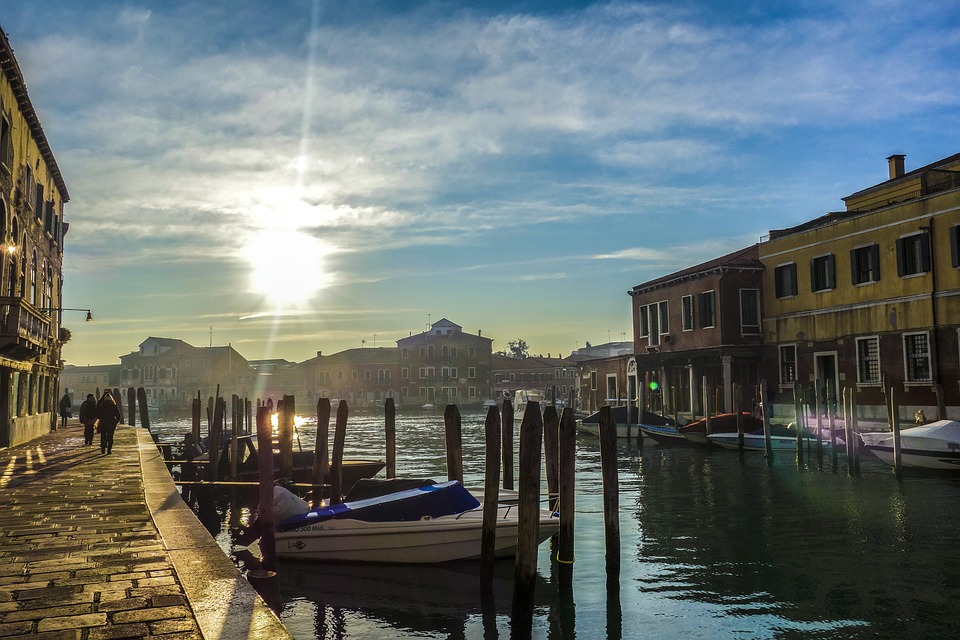
Venice Lagoon: Murano Island
The island of San Clemente is a luxury 5 star hotel itself, since 2003. Hosting several buildings with rooms, suites and a business centre. The pool, of course, and a huge well maintained garden. On the island is there a church built in 1131 to welcome the pilgrims and the soldiers leaving to the Crusades. In 1500 it turned into a monastery and an accommodation centre for famous guests, such as the Emperor Frederick II. Then there were the monks till the 1800s. Then it become a female mental hospice, where was imprisoned Benito Mussolini’s first wife Rebecca Valser. Her history is the plot of Marco Bellocchio’s movie “Vincere” and on the island you can see her memories and the letters never sent to her son. A sad story, she wasn’t insane, for sure. BTW the island is private, but you can visit it just reserving a lunch or a dinner.
My three day journey ends here, there are still so many islands to visit in the Venice Lagoon. Many of them are not accesible. The minor islands (Fisolo, Campana, ex Poveglia and Trezze, Campalto, Carbonera and Buel del Lovo) are fortresses basically, built to protect the old Republic of Serenissima, used as military bases during the First and the Second World Wars. Others are getting private, turned into luxury hotels. Just to mention some other: the islands of Poveglia, San Giorgio in Alaga, San Giacomo in Paludo, La Salina, Sant’Angelo della Polvere, Sacca San Biagio, Lio Piccolo, Sant’Andrea, Santo Spirito, Madonna del Monte, Motta dei cuniggi (i.e. rabbit’s hill), Motta San Lorenzo, Monte dell’oro, Spignon and many more. Everyone has its own history: there were monasteries, churches, hospices, lazaretti. But now they are almost abandoned or disappeared.
Hoping that these notes can help you to discover an uncommon tour around Venice!
Marco Schiavina
Visit Venice: helpful hints
Italian name: Venezia
Arrival
The Venice Airport is an international airport. To reach the city centre you can take a bus (it takes 20 minutes and costs 8€) or either a boat to cross the lagoon (15€). The nearest airport for transcontinental flights is the Bologna Airport. From the airport, first you have to reach Bologna Central Station by bus (rides every 15 minutes, it takes 30 minuts, 6€). Then, from the Central Station you can choose between the train and the bus to get to Venice. There are many trains (you can choose between Trenitalia or Italo companies), reaching Venice in 1h 30. Otherwise you can choose Flixbus and get to Venice in 2 hours.
Transports
The best way to visit Venice is on foot and across the lagoon and the canals by vaporetto ferry boat (single ticket: 7,5€ for 75 minutes). Check the ACTV website for more.
You may also enjoy a tour on the famous gondole, the typical venetian slim boats floating on the canals led by standing men… why not, just consider that it is a quite expensive tourist experience: a day tour is about 80€, by night about 100€.
What to do
Venice is the capital city of Veneto region, North Eastern Italy. No need of introduction, we guess. Venice is one of the Italian symbols worldwide, one of the most iconic place in the world, with tons of imitations, from Far East to Vegas.
The whole lagoon and part of the city are a UNESCO World Heritage Site. Highlights, for sure Piazza San Marco and the Palazzo Ducale. The canals, of course – Canal Grande on top – with all the romantic bridges crossing them (perfect location for proposals and love swearing, by the way). Read a full itinerary by our US Ambassador Virginia, while here you can find some ideas for a one day tour.
The Venice Lagoon counts up to 118 small islands, see Burano, famous for its colorful houses, and Murano famous for the craft production of glass. Here is a full itinerary touching many of the islands.
Planning your trip, try to be in Venice in February to attend its majestic Carnival celebrations (check Carnevale di Venezia official web site for updates). Check also The Biennale web site for the events of arts & architecture fair and to attend the great Venice Film Festival.
Where to sleep
In Venice everything is very expensive, accomodation included. A better choice to save some money would be to sleep in the nearby cities like Mestre or Padua, reaching Venice just for sightseeing.

